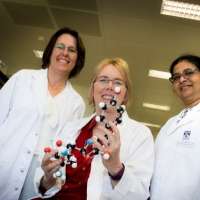Research to help fight multi-resistant bacteria

An international collaboration led by scientists from The University of Western Australia has uncovered the three-dimensional molecular structure of a protein, called EptA, which is responsible for multi-drug resistance in many disease-causing bacteria.
Multi-drug resistance in bacteria has been identified as a major worldwide public health concern by the World Health Organization.
Multi-drug resistant bacteria are responsible for approximately 700,000 deaths per year, a figure which the WHO says could reach 10 million by the year 2050.
EptA causes multi-drug resistance by masking bacteria against both the human immune system and important classes of antibiotics.
A very similar variant of EptA called MCR-1 was discovered in 2015 causing resistance to colistin, a last resort antibiotic for bacteria untreatable by other means.
Alarmingly, MCR-1 is not limited to a single type of bacteria, but is able to spread between different species of bacteria increasing its harmfullness significantly.
Lead scientist in the study, Professor of Structural Biology Alice Vrielink from UWA's School of Molecular Sciences, said the researchers used a technique called X-ray crystallography to map three-dimensional shape of EptA.
"The function of a protein molecule is directly related to it's three-dimensional shape," Professor Vrielink said.
"This new knowledge of the shape and unique structure of EptA (and MCR-1) will help scientists develop an effective treatment to prevent antibiotic resistance of these super bugs, a huge step forward for global health."
Work towards identifying potential new therapuetic molecules targeting EptA and MCR-1 is already underway through joint efforts by researchers at the UWA School of Molecular Sciences, the Marshall Center for Infectious Disease and the Monash Institute of Pharmaceutical Sciences.
The research is funded by National Health and Medical Research Council of Australia and included collaborations from several universities and organisations around the globe.
The research has been published in the journal Proceedings of the National Academy of Sciences (PNAS).
More information: Anandhi Anandan et al. Structure of a lipid A phosphoethanolamine transferase suggests how conformational changes govern substrate binding, Proceedings of the National Academy of Sciences (2017). DOI: 10.1073/pnas.1612927114
Journal information: Proceedings of the National Academy of Sciences
Provided by University of Western Australia




















